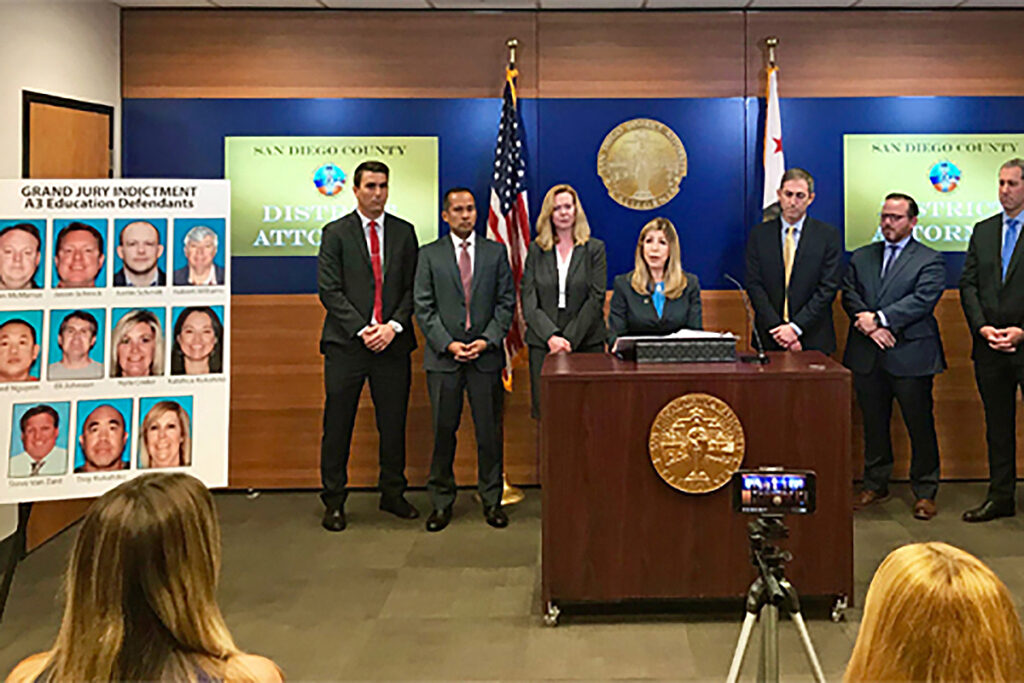
San Diego County Attorney Sumner Stephan announces in 2019 the indictment of 11 individuals affiliated with A3 Education, including founders Sean McManus and Jason Schrock, who subsequently took a plea deal.
Credit: Office of the San Diego County District Attorney
A court-commissioned task force formed in the aftermath of a massive fraud by an online charter school network issued recommendations Wednesday to thwart the recurrence of similar operations.
State Controller Malia Cohen, who chaired the task force, said that the 20 recommendations for reforming the system for auditing schools should apply not only to charter schools but also school districts and county offices of education.
The report urges significant improvement in training, selecting, overseeing and disciplining school auditors as well as an expansion of their responsibilities.
“With the education of our children at stake and significant state investments of taxpayer money in education, it is crucial that all schools be held to the highest level of integrity, accountability, fiscal compliance, and transparency,” Cohen wrote in an introduction to the 50-page “Audit Best Practices for Detecting and Curtailing Charter School Fraud.”
There were multiple failures that allowed the Academics Arts and Action Education (A3) charter network of 19 schools to pilfer tens of millions of dollars in public funding. The multi-agency task force focused on strengthening the auditing process, because a system of detecting and quickly responding to possible fraud relies on effective annual reviews by professional, independent auditors, who are overseen by Cohen’s department.
San Diego Superior Court Judge Robert Longstreth signed an order in September 2023 establishing the multi-agency task force after observing how A3 exploited weaknesses in the auditing system. A3 fraudulently enrolled participants in its summer athletic programs into the charter school’s academic program so that it could claim average daily attendance funding, even though the students received no education services. Additionally, private schools and other programs that participated in the enrollment scheme received a portion of the state’s per-student funding while A3 pocketed the rest, according to the report.
In 2021, Sean McManus and Jason Schrock, A3’s founders, pleaded guilty to a conspiracy to commit theft of public dollars for the phantom enrollments. In return for serving four years on house arrest, the executives agreed to repay $37 million.
The State Controller’s Office and the San Diego County District Attorney’s Office, which prosecuted A3, led the task force. It also included divergent perspectives from the California Charter Schools Association, the California School Boards Association, and the California County Superintendents.
Many of the recommendations will require legislative action and additional funding to implement, as noted in the report in a section titled “Obstacles and Solutions.” While charter school advocates and district authorizers agree in principle that there’s a need for changes, they have disagreed in the past over specifics of added regulation. The report called for collaboration among those with differing perspectives.
This is the third significant report this year that looked at the multiple breakdowns of oversight responsibility and holes in transparency laws that failed to spot flagrant violations by A3 and now-defunct Inspire Charter Schools, a home-school charter network that could not account for tens of millions of dollars in state funding.
The first report was a joint effort of the Legislative Analyst’s Office (LAO) and the Fiscal Crisis Management Assistance Team, a state fiscal oversight agency known as FCMAT. The second was by the anti-fraud task force of the California Charter Authorizing Professionals, a nonprofit association for school districts and county offices of education.
Both groups made similar recommendations for stronger oversight, including demanding that nonprofit charter school boards scrutinize third-party contracts for conflicts of interest.
The authorizers’ task force called for establishing a statewide Office of Inspector General to investigate and prosecute financial fraud in school districts, community colleges and charter schools.
The LAO-FCMAT report also called for limiting small school districts’ ability to authorize large-scale charter networks. Not only do they lack the knowledge and capacity to monitor complex operations, but the oversight fees they can charge, sometimes reaping millions of dollars yearly, could create an incentive to look the other way. Dehesa School District, with one school in the San Diego County foothills, chartered three A3 and two Inspire charter schools.
The failure of an audit to catch A3’s “exponential” fluctuations in enrollment was one area that the report said needed fixing. It recommends tracking enrollment and attendance changes monthly; had this been in place, an auditor may have identified a potential for fraud.
Other recommendations
Qualifying, certifying and evaluating accountants: Currently, only 22 certified public accounting firms — less than 0.1% of licensed accounting firms in California — audit 93% of school districts and charter schools, according to the report. As a result, the report stated, “The poor performance of any one CPA firm may significantly impact the quality and reliability of school audits.” And those auditing schools have not been required to have any training specifically on auditing schools.
The report recommends:
Requiring 24 hours of training on school auditing before an auditor can be listed among certified public accountants eligible for school auditing.
Requiring the State Comptroller’s Office to do a quality review after an auditor’s first school audit.
Adding conditions for deleting a poorly performing auditor from the state’s auditor eligibility list.
Frequent turnover in a charter school’s auditors can be “a red flag” for a subpar auditor or a district with possible misconduct. The report recommends monitoring for these trends.
Conflicts of interest: Some cases of charter fraud have revealed collusion between vendors with close personal ties to charter leaders, self-dealing by charter CEOs and other conflicts of interest that could lead to fraud or waste. Some boards of directors have failed in their legal responsibility to identify and prohibit them.
The report recommends financial disclosure statements for the top five highest-paid school employees, the 25 highest paid vendors, and disclosure statements for charter schools’ contracts with charter management organizations.
The report reiterates a best practice that some auditors apparently did not follow: To preserve independence, an auditor should never allow a school district or charter school to determine which financial transactions and enrollments should be sampled for an audit.
Some of the most visible cases of abuse have occurred with non-classroom based charter schools. Those are charter schools in which less than 80% of instruction occurs in person.
Consisting of hybrid charter schools and home schools, they comprise about a quarter of the state’s 1,300 charter schools and nearly 40% of charter school students. Exclusively online charter schools are only a small piece.
Non-classroom-based charter schools are also increasingly popular with parents seeking scheduling flexibility and more options in their children’s education.
In 2019, the Legislature imposed a two-year moratorium on approving new non-classroom-based charter schools and has extended it twice.
Thus, there will be pressure on the Legislature to consider the auditing and oversight reforms that the three reports have suggested before the moratorium ends in 2026.
 VIPRE Security Group, a global leader and award-winning cybersecurity, privacy, and data protection company, today announced the launch of its new VIPRE Integrated Email Security (IES) Solution.
VIPRE Security Group, a global leader and award-winning cybersecurity, privacy, and data protection company, today announced the launch of its new VIPRE Integrated Email Security (IES) Solution. 





